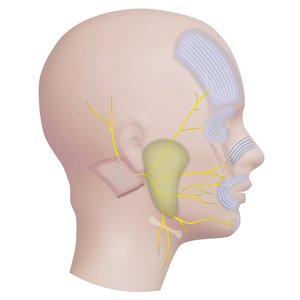Surgery in ear, nose and throat medicine is extremely delicate, complex and highly precise, as is the case with parotid surgery (parotid gland), for example. The branches of the facial nerve, in particular, extend through the parotid gland in a fan shape, making the operation a challenge for the surgeon. The monitoring, localization and functional control of the nerve fibres in the surgical field has been an established procedure for many years to support the surgeon and ensure the safety of the patient.
Neuromonitoring >> is regarded as a useful aid in many surgeries in order to make interventions as gentle and risk-free as possible for the patient. The following are some of the most common procedures in ear, nose and throat surgery where inomed products are used:

Surgery of the parotid gland often endangers the facial nerve. Thanks to inomed's facialis monitoring with the C2 Xplore, damage to the delicate nerve branches within the parotid gland and in its immediate vicinity can be avoided. The C2 Xplore software module for ENT surgery >> offers comprehensive functionality for facialis monitoring at the highest level.
Neuromonitoring is applied in two ways: direct contact of surgical instruments with nerve fibres or their strain by tension or pressure are indicated acoustically and visually by means of permanent electromyographic discharge (EMG). Hand-guided probes can be used to locate the various nerve branches and their course within the parotid artery. These instruments directly stimulate the nerves electrically and show the resulting electrophysiological signals of the muscles in the form of image and sound signals.
In thyroid surgery >> neuromonitoring can help to prevent injuries of the vocal cord nerves and the resulting temporary or complete paralysis of the vocal cord.
The removal of acoustic neuroma (benign tumours of the sheath cells of the vestibulocochlear nerve) particularly endangers the facial nerve and the auditory nerve. However, other cranial nerves and structures of the brain stem can also be injured during surgery.
The ISIS IOM systems >> (ISIS Xpert, ISIS Xpert plus, ISIS Xpress) make it possible to continuously monitor all nerve functions using EMG, MEP, SEP and AEP modalities.
The motor and sensory evoked potentials (MEP, SEP) monitor the long pathways that pass through the brain stem from the cerebrum and into the spinal cord.
Electromyography can detect irritations of the facial nerve and other cranial nerves and allow the surgeon to adjust the surgical strategy before damage occurs. Using stimulation probes, endangered structures can be safely identified and spared even under indistinct surgical conditions.
The hearing function can be continuously monitored during the procedure with the aid of acoustically evoked potentials (AEP).
Neuromonitoring can thus help to remove the tumour as gently as possible, simultaneously monitoring hearing and other nerve functions.
When a tympanoplasty is performed or a cochlear implant is inserted, inomed neuromonitoring is a valuable tool during surgical access to prevent injury to the local nerve tissue. In mastoidectomy, too, neuromonitoring serves to reduce the risk of injury when milling the bony facial canal.